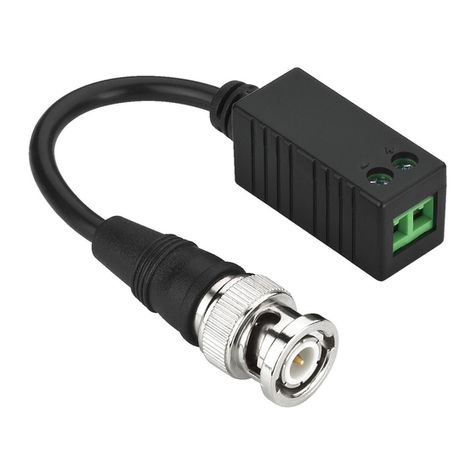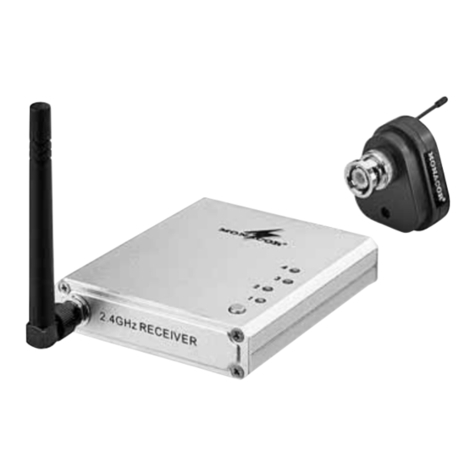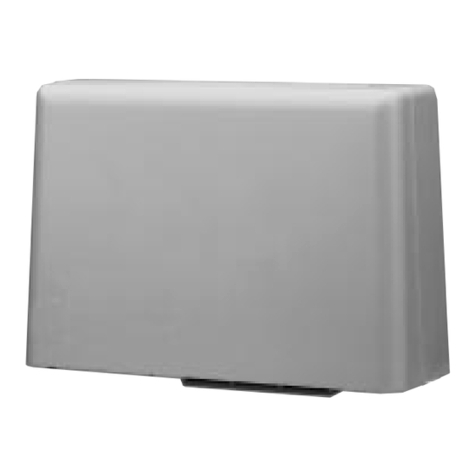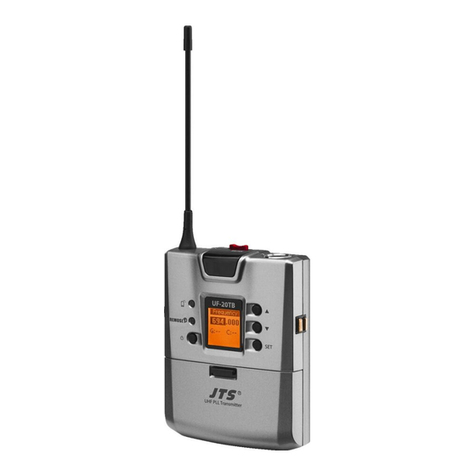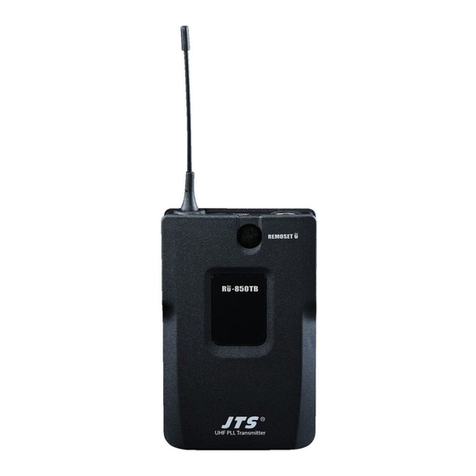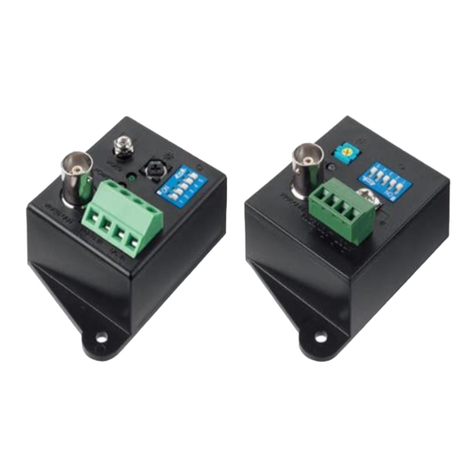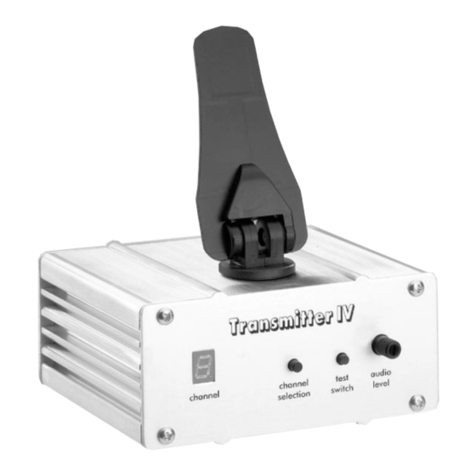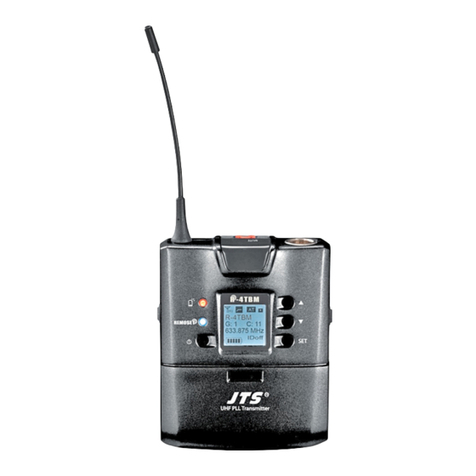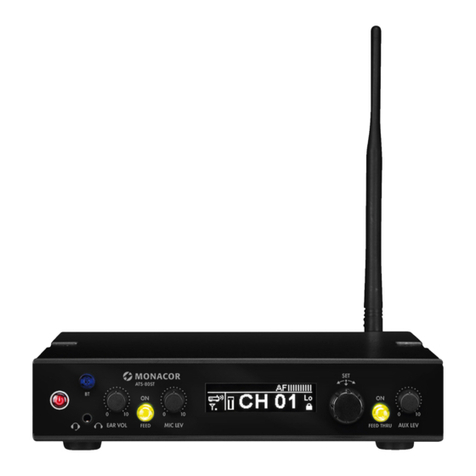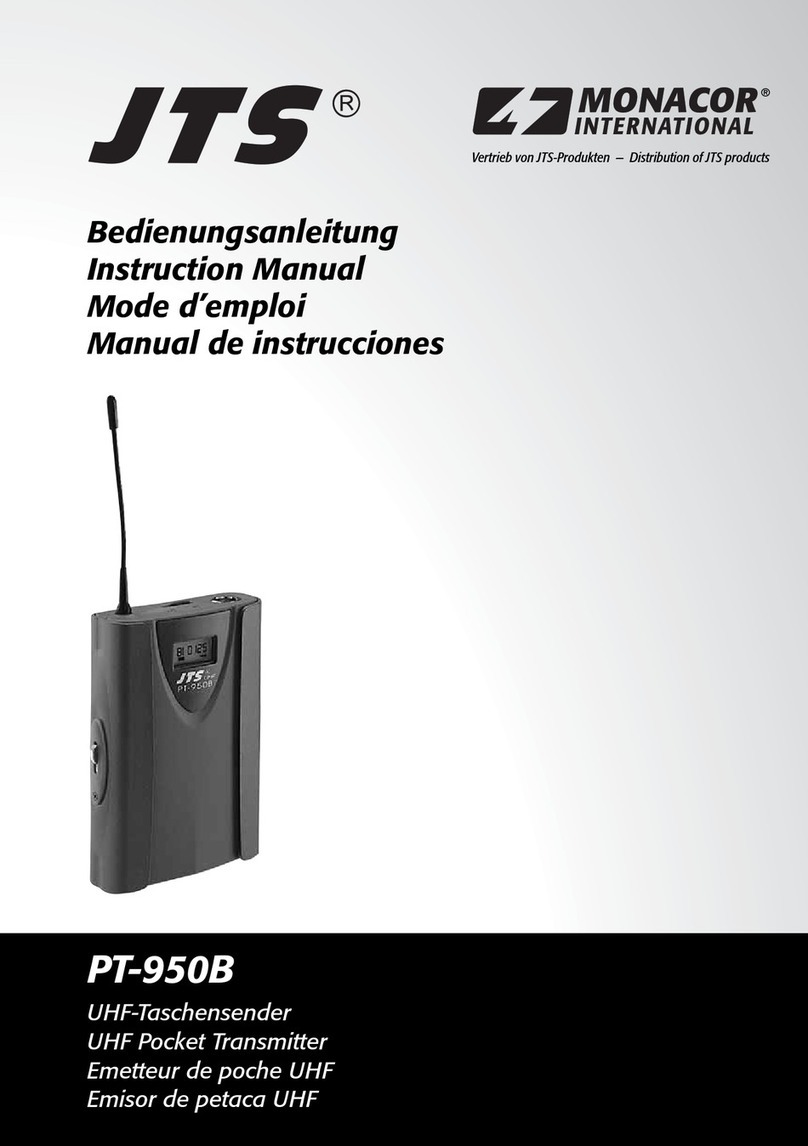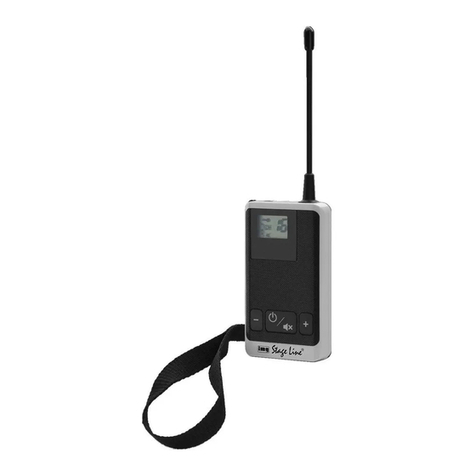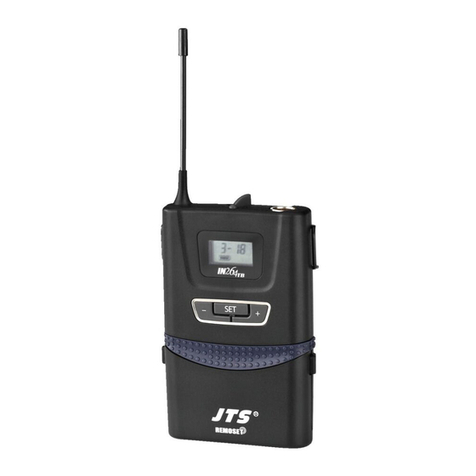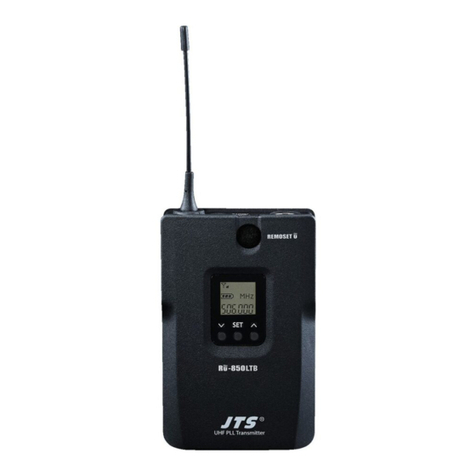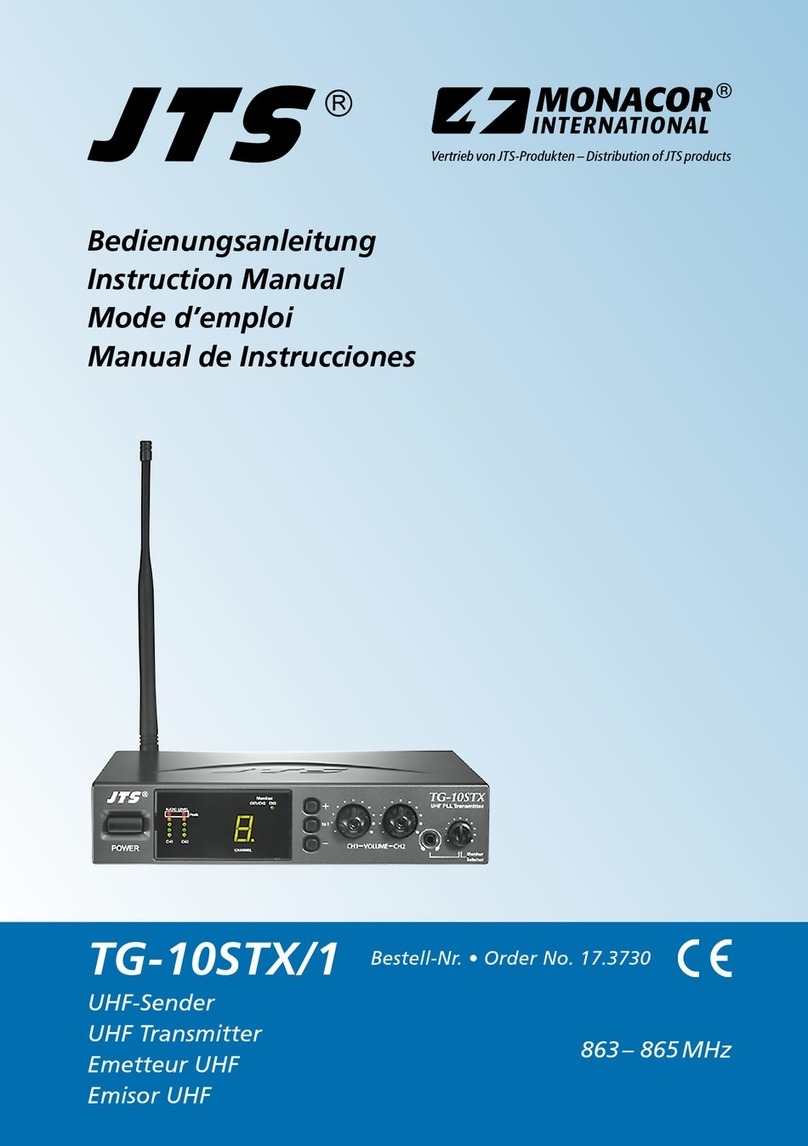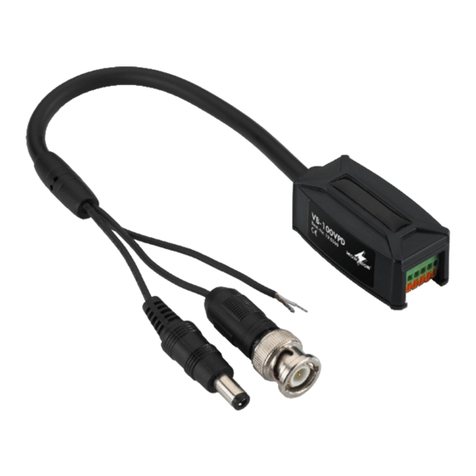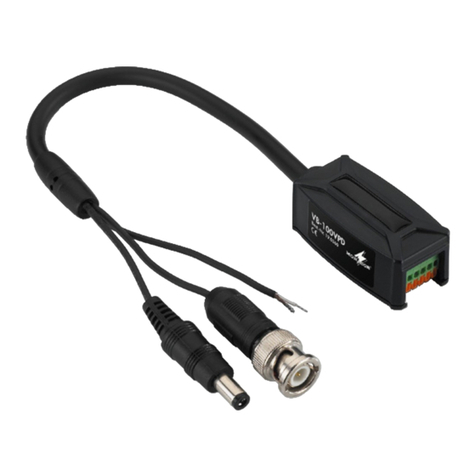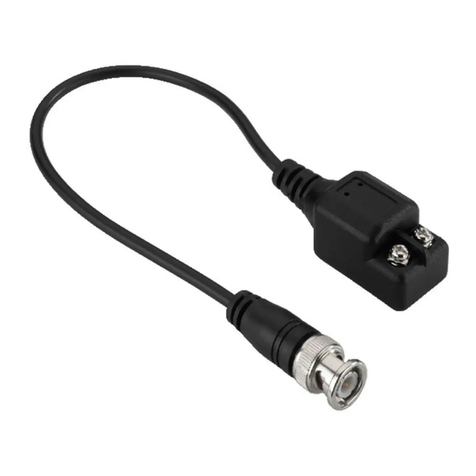Emetteur de poche multifréquences
823-832 MHz et 863-865 MHz
Veuillez lire la présente notice avec attention
avant le fonctionnement et conservez-la pour
pouvoir vous y reporter ultérieurement.
1 Possibilités dʼutilisation
Cet émetteur de poche est prévu pour fonctionner avec un
micro serre-tête ou un micro oreillette de “img Stage Line”
(HSE-…) avec connexion mini XLR 3 pôles. Lorsque le
micro est relié, il constitue, avec le récepteur TXS-900 ou
TXS-920, un système de transmission audio sans fil.
Conformité et déclaration
Par la présente, MONACOR INTERNATIONAL déclare
que lʼémetteur TXS-900HSE se trouve en conformité
avec les exigences fondamentales et les réglementa-
tions inhérentes à la directive 1999/5/CE. Vous pouvez
demander la déclaration de conformité auprès de
MONACOR INTERNATIONAL. Lʼémetteur est autorisé
pour un fonctionnement dans les pays de l'Union euro-
péenne et de l'A.E.L.E. sans déclaration ni taxe, mais
la plage de fréquence 823 – 832 MHz n'est pas auto-
risée en France.
2 Conseils importants d'utilisation
Lʼappareil répond à toutes les directives nécessaires de
lʼUnion européenne et porte donc le symbole .
GLʼappareil nʼest conçu que pour une utilisation en in-
térieur. Protégez-le de tout type de projections d'eau,
des éclaboussures, d'une humidité de l'air élevée et
de la chaleur (plage de température de fonctionne-
ment autorisée : 0 – 40 °C).
GEn cas de non utilisation prolongée, retirez les batte-
ries ; elles pourraient couler et endommager lʼappareil.
GPour le nettoyage, utilisez uniquement un chiffon sec
et doux, en aucun cas de produits chimiques ou dʼeau.
GNous déclinons toute responsabilité en cas de dom-
mages matériels ou corporels si lʼappareil est utilisé
dans un but autre que celui pour lequel il a été conçu,
s'il n'est pas correctement branché ou utilisé ou sʼil
nʼest pas réparé par un technicien habilité ; en outre,
la garantie deviendrait caduque.
3 Eléments et branchement
1Antenne
2Affichage, indique
– le canal réglé : CH 001 … CH 442 (voir tableau)
– lʼétat des batteries : BATT
Si le symbole de batterie BATT clignote, les batte-
ries sont presque déchargées.
3LED de contrôle
rouge = émetteur allumé
bleu = son du micro coupé
blignote = les batteries sont presque déchargées,
durée de fonctionnement restante infé-
rieure à 10 minutes
4Touche rouge pour allumer/éteindre (maintenez la
touche enfoncée 1 seconde environ) et pour activer/
désactiver la coupure du son (enfoncez la touche
brièvement)
5Entrée pour un microphone serre-tête ou oreillette de
la série HSE-… de IMG Stage Line, disposant dʼun
branchement mini XLR 3 pôles (p. ex. HSE-60A/SK,
HSE-80, HSE-110).
6Sélecteur GAIN pour le signal micro
Réglez lʼamplification de telle sorte quʼun niveau op-
timal du signal micro soit atteint : si lʼamplification est
trop élevée, le signal micro est distordu, mettez alors
le sélecteur sur 0 ou
-
10 dB. Si lʼamplification est trop
faible, on a un mauvais rapport signal/bruit, mettez
alors le sélecteur sur 0 ou +10 dB.
7Touche bleue pour régler lʼémetteur sur le canal de
transmission du récepteur :
1. Maintenez la touche enfoncée pour que l'indication
SYNC clignote sur lʼaffichage du récepteur.
(Lʼémetteur ne doit pas être allumé.)
Ne jetez pas les batteries usagées dans la poubelle do-
mestique. Déposez-les dans un container spécifique ou ra-
menez-les chez votre détaillant.
Lorsque lʼappareil est définitivement retiré du ser-
vice, vous devez le déposer dans une usine de
recyclage de proximité pour contribuer à son élimi-
nation non polluante.
TXS-900HSE
Order No. 25.5250
wwwwww..iimmggssttaaggeelliinnee..ccoomm
®
MONACOR INTERNATIONAL GmbH & Co. KG
•
Zum Falsch 36
•
28307 Bremen
•
Germany
Copyright
©
by MONACOR INTERNATIONAL. All rights reserved. A-1545.99.01.03.2014
F
B
CH
I
Canal
Canale
Fréquence
Frequenza
Canal
Canale
Fréquence
Frequenza
CH 001 823,000 MHz CH 362 863,000 MHz
CH 002 823,025 MHz CH 363 863,025 MHz
CH 003 823,050 MHz CH 364 863,050 MHz
CH 004 823,075 MHz CH 365 863,075 MHz
CH 005 823,100 MHz CH 366 863,100 MHz
… … … …
CH 360 831,975 MHz CH 441 864,975 MHz
CH 361 832,000 MHz CH 442 865,000 MHz
Trasmettitore tascabile
a multifrequenza
823 – 832 MHz e 863 – 865 MHz
Vi preghiamo di leggere attentamente le presenti istru-
zioni prima della messa in funzione e di conservarle per
un uso futuro.
1 Possibilità d'impiego
Questo trasmettitore tascabile è previsto per l'impiego
con un microfono headset o archetto di “img Stage
Line” (HSE-...) con contatto XLR mini a 3 poli. Con il
microfono collegato, in combinazione con il ricevitore
TXS-900 o TXS-920, costituisce un sistema wireless di
trasmissione audio.
Conformità e omologazione
MONACOR INTERNATIONAL dichiara che il trasmetti-
tore TXS-900HSE è conforme a tutti i requisiti di base e
alle rimanenti disposizioni in materia della direttiva
1999/5/CE. La dichiarazione di conformità può essere
richiesta presso MONACOR INTERNATIONAL. Il tra-
smettitore è omologato per l'impiego negli stati dell'UE
e dell'EFTA e non richiede né registrazione né paga-
mento di tasse.
2 Avvertenze importanti per l'uso
Questʼapparecchio è conforme a tutte le direttive rile-
vanti dellʼUE e pertanto porta la sigla .
GUsare lʼapparecchio solo allʼinterno di locali e proteg-
gerlo dall'acqua gocciolante e dagli spruzzi d'acqua,
da alta umidità dell'aria e dal calore (temperatura dʼim-
piego ammessa fra 0 e 40 °C).
GPer proteggere l'apparecchio dalle batterie che per-
dono conviene toglierle in caso di mancato uso pro-
lungato.
GPer la pulizia usare solo un panno morbido, asciutto;
non impiegare in nessun caso acqua o prodotti chimici.
GNel caso dʼuso improprio, di collegamenti sbagliati,
dʼimpiego scorretto o di riparazione non a regola dʼarte
dell'apparecchio, non si assume nessuna responsabilità
per eventuali danni consequenziali a persone o a cose
e non si assume nessuna garanzia per l'apparecchio.
3 Elementi di comando e collegamento
1Antenna
2Display, indica
– il canale impostato: CH 001 … CH 442
(vedi anche la tabella)
– lo stato delle batterie: BATT
Se la spia BATT lampeggia, significa che le batte-
rie sono quasi scariche.
3LED di controllo
rosso = trasmettitore attivato
blu = microfono messo in muto
lampeggia = batterie quasi scariche, durata residua
meno di 10 minuti
4Tasto rosso per attivare/disattivare (tener premuto per
1 sec ca.) e per mettere in muto/riattivare l'audio (pre-
mere brevemente)
5Ingresso per un microfono headset o archetto della
serie HSE-… di “img Stage Line” con contatto XLR
mini a 3 poli (p. es. HSE-60A/SK, HSE-80, HSE-110)
6Interruttore a scorrimento GAIN per il segnale del
microfono
Impostare il guadagno in modo tale che si raggiunge
un livello ottimo del segnale del microfono: Con un
guadagno troppo forte, il segnale del microfono risulta
distorto; allora portare l'interruttore su 0 o
-
10 dB.
Con un guadagno troppo basso, il rapporto segnale/
rumore diventa sfavorevole; allora portare l'interrut-
tore su 0 o +10 dB.
7Tasto blu per impostare sul trasmettitore il canale di
trasmissione del ricevitore:
1. Tener premuto il tasto: sul display del ricevitore
lampeggia la spia SYNC. (Non è necessario che il
trasmettitore sia acceso.)
Non gettare le batterie scariche o difettose nelle immondi-
zie di casa bensì negli appositi contenitori (p. es. presso il
vostro rivenditore).
Se si desidera eliminare l'apparecchio definitiva-
mente, consegnarlo per lo smaltimento ad un'istitu-
zione locale per il riciclaggio.
2. Sul ricevitore premere nello stesso tempo breve-
mente il tasto SYNC: Sul trasmettitore viene impo-
stato il canale del ricevitore e il trasmettitore
rimane acceso.
Durante questa regolazione, la distanza fra il trasmet-
titore e il ricevitore non deve essere superiore a 1 m.
8Clip per fissare il trasmettitore ai vestiti (p. es. al cin-
turino o alla cintura)
9Coperchio del vano batterie; per aprirlo esercitare una
pressione sulla zona evidenziata, spostare il coperchio
verso il basso e aprirlo. Inserire due batterie stilo come
segnato nel vano batterie e richiudere il coperchio.
4 Dati tecnici
Gamma delle
radiofrequenze: . . . . . . . 823 – 832 MHz e 863 – 865 MHz
(vedi anche la tabella)
Potenza di trasmissione: 10 mW (EIRP)
Stabilità di frequenza: . . . ±0,005 %
Gamma di
frequenze audio: . . . . . . . 80 – 18 000 Hz
Contatto: . . . . . . . . . . . . . XLR mini, 3 pin, 10 V= alimenta-
zione per il microfono (con pin 3)
Alimentazione: . . . . . . . . 2 × batteria stilo 1,5 V (AA)
Durata: . . . . . . . . . . . . . . > 15 h
Dimensioni, peso: . . . . . . 65 × 110 × 25 mm, 90 g
Con riserva di modifiche tecniche.
2. Sur le récepteur, appuyez simultanément et briè-
vement sur la touche SYNC : lʼémetteur est réglé
sur le canal du récepteur et est allumé.
Pour effectuer les réglages, lʼémetteur et le récepteur
ne doivent pas être éloignés de plus de 1 m lʼun de
lʼautre.
8Clip de ceinture pour fixer lʼémetteur sur un vêtement
(par exemple ceinture)
9Couvercle du compartiment batterie ; pour ouvrir ap-
puyez sur la surface repérée, poussez le couvercle
vers le bas et ouvrez. Insérez deux batteries de type
R6 comme indiqué dans le compartiment et refermez.
4 Caractéristiques techniques
Plage de fréquence radio : 823 – 832 MHz et 863 – 865 MHz
(voir tableau)
Puissance émission : . . . . 10 mW (EIRP)
Stabilité fréquence : . . . . . ±0,005 %
Plage de fréquence audio : 80 – 18 000 Hz
Branchement : . . . . . . . . . mini XLR, 3 pins, 10 V
tension ali-
mentation pour le micro (au pin 3)
Alimentation : . . . . . . . . . . 2 × batterie 1,5 V de type R6
Durée fonctionnement : . . > 15 h
Dimensions, poids : . . . . . 65 × 110 × 25 mm, 90 g
Tout droit de modification réservé.
